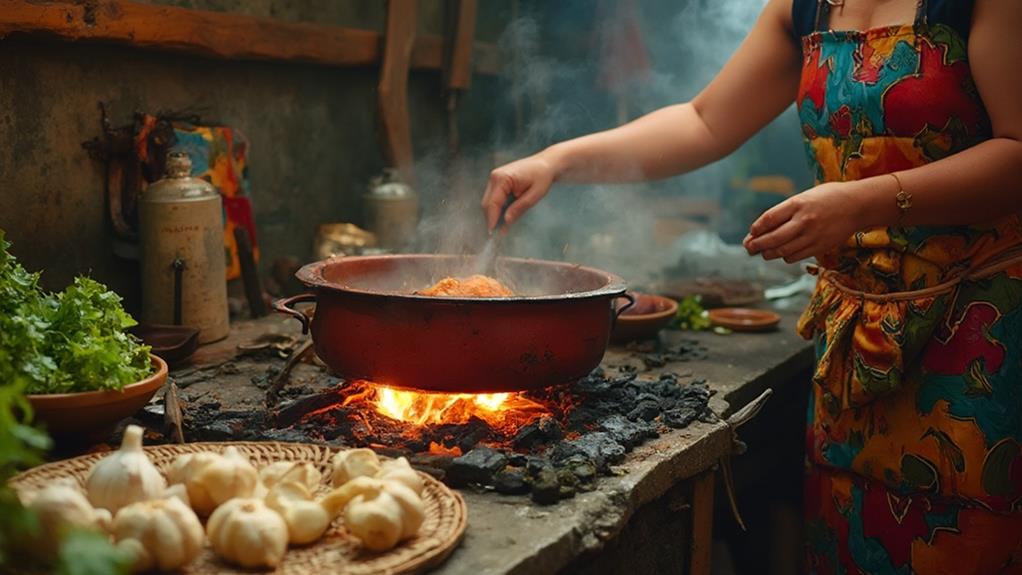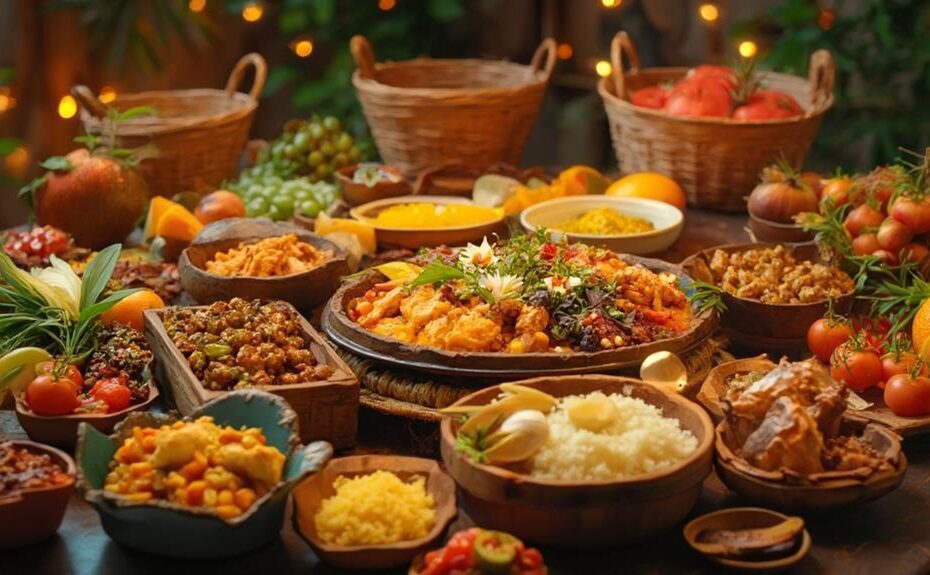Filipino cuisine is a unique blend of flavors and cultures. The Philippines' cultural diversity is reflected in its food, with influences from Malay, Spanish, and other cultures evident in every dish.
Rice and soy sauce are essential ingredients that bring harmony to traditional Filipino dishes, such as adobo, which showcases time-honored cooking techniques.
Each meal tells a story. For example, lechon, a whole roasted pig, is often served at special occasions like weddings, while sinigang, a sour soup, is a comforting and nourishing meal.
Filipino cuisine not only delights the taste buds but also promotes well-being through nutritious ingredients and mindful cooking practices. This approach to food makes every gathering a joyful experience.
The Rich History of Filipino Cuisine
Filipino cuisine is a rich tapestry of history, woven from various cultural influences. The country's culinary landscape reflects centuries of interaction between indigenous practices and foreign influences, including Malay, Chinese, Spanish, and American flavors.
The strong foundation of indigenous roots in Filipino cuisine is reflected in the blending of local ingredients with foreign techniques. Adobo, a dish that showcases the indigenous method of marinating meat, is a prime example of this blending. This cooking method likely evolved during the Spanish colonial period, combining local ingredients with European techniques.
The vibrant street food scene in the Philippines is a testament to the everyday eating habits of Filipinos. Popular street foods like lumpia and isaw showcase the blending of local ingredients with foreign techniques.
Regional specialties in the Philippines reveal the country's cultural diversity. Cebu's lechon, known for its crispy skin, and Mindanao's spicy rendang are two examples of regional dishes that reflect the climate, geography, and traditions of their respective regions.
Each dish tells a story, reflecting the generations of resilience and creativity that define the Filipino spirit.
Key Ingredients and Their Significance
Rice is the cornerstone of many Filipino meals, symbolizing life and sustenance. It's often paired with a variety of dishes, including savory adobo and sweet leche flan.
Soy sauce is an essential condiment that adds depth and umami flavor to many dishes. It bridges the gap between the islands' diverse culinary influences, bringing harmony to the flavors.
Garlic and onions are staples in Filipino cuisine, infusing dishes with warmth and aroma. They create layers of flavor in recipes, transporting you to a family gathering or festive celebration.
For example, they're used in adobo, a popular Filipino dish made with meat or seafood, vinegar, and spices.
Fish sauce, or patis, enhances the complexity of flavors in dishes like sinigang. Its salty bite balances the sour and savory flavors in this traditional Filipino soup.
Tamarind adds a tangy essence to soups, balancing sweetness and acidity in a unique way. It's a key ingredient in sinigang, where it combines with fish sauce to create a harmonious flavor profile.
Vegetables like eggplant and bitter melon contribute nutrition and showcase the archipelago's rich agricultural diversity. They're used in a variety of dishes, including soups, stews, and stir-fries, adding flavor, texture, and nutrients to each meal.
Traditional Cooking Techniques

Filipino cuisine relies on traditional cooking techniques that have been passed down through generations.
Adobo is a beloved technique where meats are marinated in a mixture of vinegar, soy sauce, and spices before being simmered until tender. This method not only preserves the meat but infuses it with deep, savory notes.
For example, chicken or pork can be marinated in a mixture of vinegar, soy sauce, garlic, and bay leaves before being simmered until tender, resulting in a flavorful dish.
Another technique is sinangag, or garlic fried rice, which uses leftover rice. To make sinangag, leftover rice is sautéed with garlic, onions, and sometimes tomatoes, making it both practical and delicious.
Lutong bahay, or home cooking, emphasizes slow-cooking methods. One such method is pinangat, where fish or meat is wrapped in leaves and simmered gently, allowing flavors to meld beautifully.
For instance, fish can be wrapped in banana leaves with onions, garlic, and tomatoes, then simmered in water until cooked, resulting in a flavorful and aromatic dish.
How Can Filipino Cuisine Contribute to Children’s Well-being and Nutrition?
Filipino food options for kids play a significant role in promoting children’s well-being and nutrition. Incorporating traditional dishes like adobo, sinigang, and fresh fruits into their diets provides essential nutrients and introduces them to diverse flavors and ingredients. This can aid in developing healthy eating habits from a young age.
Celebratory Dishes for Special Occasions
Celebratory Dishes in the Philippines
Weddings and Birthdays
In the Philippines, special occasions like weddings and birthdays are celebrated with traditional dishes that reflect the country's rich culture.
At weddings, lechon, an entire roasted pig, is often the centerpiece, with its crispy skin and tender meat inviting everyone to dig in.
For birthdays, pancit, a sweet and savory noodle dish symbolizing long life, is a must-have, often garnished with colorful vegetables and meats.
Lechon: A Symbol of Celebration
The art of lechon roasting is a centuries-old practice that symbolizes celebration in Filipino culinary traditions.
In fact, over 1000 creatively dressed lechons are paraded during the Parada ng Lechon festival in Balayan, Batangas.
Christmas and Fiestas
During Christmas, bibingka and puto bumbong, delightful rice cakes, fill the senses with warmth and nostalgia.
At fiestas, a table is laden with a variety of dishes, from adobo to kare-kare, showcasing the region's unique flavors.
Desserts
Leche flan, a rich caramel custard, often graces the table, and halo-halo, a mixed dessert of shaved ice and sweet ingredients, adds a refreshing touch to any gathering.
These celebratory dishes not only tantalize the taste buds but also weave a tapestry of tradition, love, and togetherness, making each occasion memorable.
The Role of Food in Filipino Culture

Food plays a vital role in Filipino culture, going beyond just providing sustenance.
When Filipinos gather for a meal, they're not just sharing dishes; they're participating in a rich tradition that spans generations. Each meal becomes a narrative, telling stories of family, heritage, and community. For instance, the centuries-old practice of lechon roasting symbolizes celebration and festivity, bringing people together. The sizzling sound of a lechon being roasted and the sweet aroma of bibingka wafting through the air evoke memories and emotions.
Mealtimes often transform into festive gatherings, where laughter and conversation flow as freely as the dishes being served. In Filipino culture, sharing food is a gesture of love and hospitality. When you invite someone to your home, it's customary to offer a plate, reinforcing bonds and fostering connections.
Festivals and celebrations revolve around food, showcasing regional specialties and culinary skills that reflect local traditions and resources. Whether it's a simple home-cooked meal or a grand feast, every dish carries significance. Food is more than just nourishment; it's a celebration of life, a means of connection, and an expression of identity that defines the Filipino experience.
Health Benefits of Filipino Meals
Filipino Meals: A Delicious Blend of Flavor and Nutrition
Filipino cuisine is renowned for its vibrant flavors, which are often paired with nutritious ingredients. This harmonious combination provides a feast for the taste buds while nourishing the body.
Essential Vitamins and Nutrients
Classic Filipino dishes like sinigang and adobo are rich in essential vitamins and nutrients. The sourness of tamarind in sinigang provides vitamin C, while the lean proteins in adobo, typically chicken or pork, are packed with protein, B vitamins, and minerals.
Promoting Physical Fitness
Engaging in traditional Philippine folk dances not only promotes physical fitness but can also be sustained by consuming Filipino meals that incorporate fresh vegetables and herbs.
These ingredients provide the necessary energy and boost overall physical fitness.
Fresh Vegetables and Herbs for Better Health
Many Filipino meals incorporate fresh vegetables, such as leafy greens, eggplants, and bitter melons, which are low in calories and high in fiber.
These ingredients aid digestion and help maintain a healthy weight.
Herbs and spices like ginger and garlic not only enhance flavor but also offer anti-inflammatory properties and boost the immune system.
Mindful Eating for Better Digestion
The traditional practice of sharing meals encourages mindful eating, where every bite is savored, leading to better digestion and satisfaction.
This mindful approach to eating is essential for overall well-being.
Celebrating Flavor and Well-being
Filipino cuisine celebrates both flavor and well-being.
